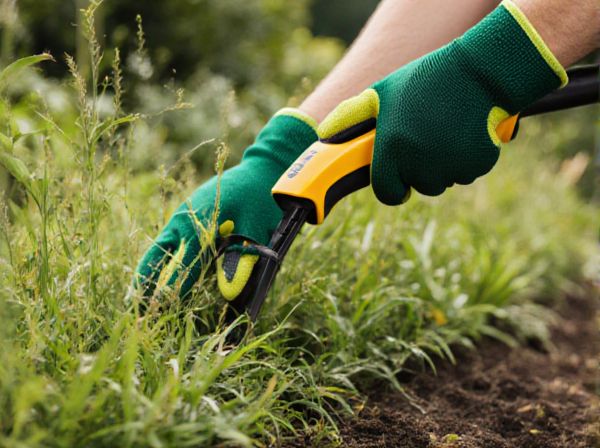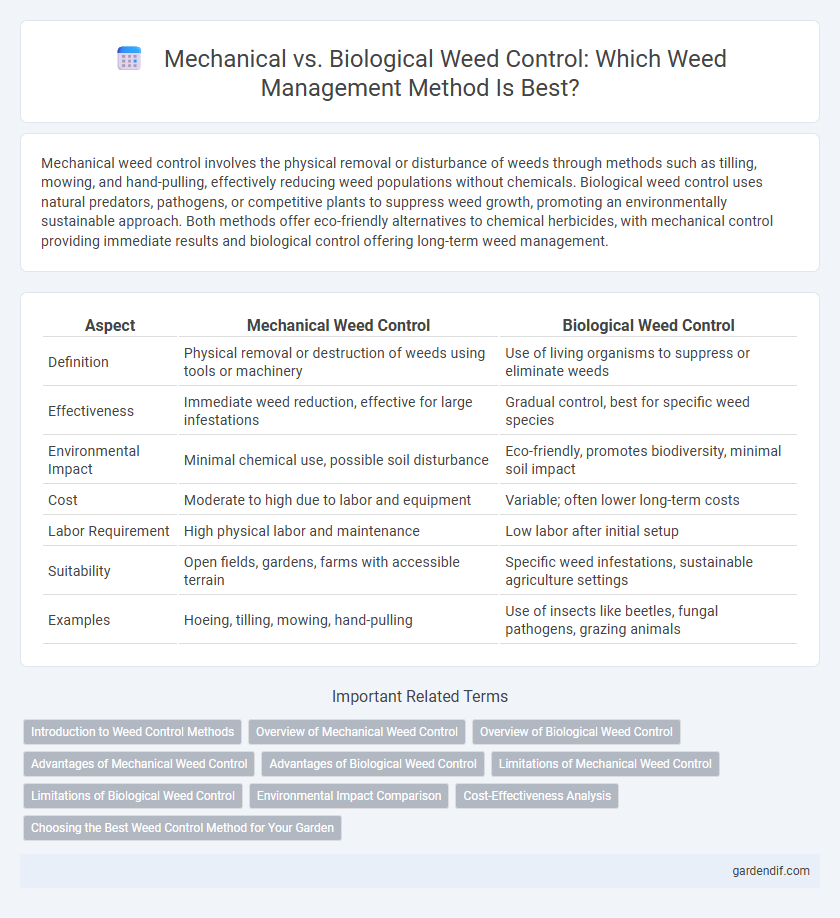
Mechanical weed control vs biological weed control Illustration
Mechanical weed control involves the physical removal or disturbance of weeds through methods such as tilling, mowing, and hand-pulling, effectively reducing weed populations without chemicals. Biological weed control uses natural predators, pathogens, or competitive plants to suppress weed growth, promoting an environmentally sustainable approach. Both methods offer eco-friendly alternatives to chemical herbicides, with mechanical control providing immediate results and biological control offering long-term weed management.
Table of Comparison
| Aspect | Mechanical Weed Control | Biological Weed Control |
|---|---|---|
| Definition | Physical removal or destruction of weeds using tools or machinery | Use of living organisms to suppress or eliminate weeds |
| Effectiveness | Immediate weed reduction, effective for large infestations | Gradual control, best for specific weed species |
| Environmental Impact | Minimal chemical use, possible soil disturbance | Eco-friendly, promotes biodiversity, minimal soil impact |
| Cost | Moderate to high due to labor and equipment | Variable; often lower long-term costs |
| Labor Requirement | High physical labor and maintenance | Low labor after initial setup |
| Suitability | Open fields, gardens, farms with accessible terrain | Specific weed infestations, sustainable agriculture settings |
| Examples | Hoeing, tilling, mowing, hand-pulling | Use of insects like beetles, fungal pathogens, grazing animals |
Introduction to Weed Control Methods
Mechanical weed control utilizes physical methods such as hoeing, tilling, and mulching to disrupt weed growth and reduce weed populations without chemicals. Biological weed control involves using natural predators, pathogens, or competitive plants to suppress weed species, promoting a sustainable and eco-friendly approach. Both methods serve as integral components in integrated weed management systems to minimize herbicide reliance and environmental impact.
Overview of Mechanical Weed Control
Mechanical weed control involves physical methods such as tilling, hoeing, mowing, and hand-pulling to manage weed populations by directly removing or damaging unwanted plants. This approach reduces reliance on chemical herbicides, promoting sustainable agriculture and minimizing environmental impact. Equipment selection and timing are crucial factors, ensuring effective weed suppression while preserving crop health.
Overview of Biological Weed Control
Biological weed control uses natural predators, pathogens, or competitive plants to reduce weed populations sustainably without synthetic chemicals. This method targets specific weed species, minimizing environmental impact and promoting long-term ecosystem balance. Examples include introducing insects like beetles that feed on invasive weeds or deploying fungi that infect weed roots.
Advantages of Mechanical Weed Control
Mechanical weed control offers precise management by physically removing weeds, reducing reliance on chemical herbicides and lowering environmental impact. It enables targeted treatment in various crop systems, promoting soil aeration and minimizing chemical residues in the ecosystem. This method supports sustainable agriculture by enhancing soil health and facilitating integrated weed management strategies.
Advantages of Biological Weed Control
Biological weed control utilizes natural predators or pathogens to sustainably reduce weed populations, minimizing environmental impact compared to mechanical methods. This approach promotes ecosystem balance by targeting specific invasive species without harming non-target plants or soil health. Lower labor and energy costs enhance the long-term cost-effectiveness of biological weed control in agriculture and land management.
Limitations of Mechanical Weed Control
Mechanical weed control faces significant limitations including soil disturbance, which can lead to erosion and degradation of soil structure. It is often labor-intensive and less effective against deep-rooted or perennial weed species, requiring repeated applications. These constraints reduce its efficiency and sustainability compared to biological weed control methods that leverage natural weed suppression mechanisms.
Limitations of Biological Weed Control
Biological weed control faces limitations such as slow establishment and inconsistent efficacy due to environmental variability and specific host requirements of agents. Its impact can be site-specific and often requires several seasons to observe significant weed reduction, limiting its immediate effectiveness. Additionally, the risk of non-target effects and the difficulty in controlling a broad spectrum of weed species pose challenges compared to mechanical weed control methods.
Environmental Impact Comparison
Mechanical weed control involves physical removal methods such as tilling or mowing, which can disrupt soil structure and lead to erosion, affecting local biodiversity negatively. Biological weed control uses natural predators or pathogens to reduce weed populations, minimizing chemical inputs and preserving soil health and ecological balance. Studies show biological control generally has a lower environmental footprint, promoting sustainable agriculture by reducing the reliance on fossil fuel-powered machinery and synthetic herbicides.
Cost-Effectiveness Analysis
Mechanical weed control incurs higher upfront costs due to investment in equipment and labor but offers immediate, consistent results with minimal ecological disruption. Biological weed control involves lower initial expenses by utilizing natural predators or pathogens, yet it may require longer periods to achieve desired weed suppression and monitoring costs can vary. Cost-effectiveness analysis shows mechanical methods are preferable for rapid, large-scale weed management, while biological control is economically viable for long-term, sustainable weed reduction in eco-sensitive areas.
Choosing the Best Weed Control Method for Your Garden
Mechanical weed control provides immediate removal by physically uprooting weeds, making it effective for small gardens with accessible soil. Biological weed control uses natural predators or pathogens, offering a sustainable and eco-friendly solution ideal for long-term management and organic gardening. Selecting the best method depends on garden size, weed species, and environmental impact preferences, with an integrated approach often yielding optimal results.
Mechanical weed control vs biological weed control Infographic

 gardendif.com
gardendif.com